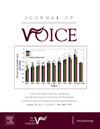Comparison of Client-Led Asynchronous and Clinician-Led Synchronous Online Methods for Evaluation of Subjective Vocal Measures in Teachers: A Feasibility Study
IF 2.5
4区 医学
Q1 AUDIOLOGY & SPEECH-LANGUAGE PATHOLOGY
引用次数: 0
Abstract
Background
COVID-19 has transformed face to face teaching in classrooms to online and hybrid modes. Increased vocal intensity/ pitch to call attention of students and transact in the online class, inappropriate posture (head, neck & upper trunk) while using the laptop and other online tools cause vocal loading leading to voice related concerns in teachers. Tele voice assessment is a feasible alternative means to seek professional help in the current situation and possibly in the future too. Client-led asynchronous and clinician-led synchronous voice recordings for clinical vocal measures among school teachers were compared in this study.
Method
Twenty-five school teachers (21 females & four males) from Chennai consented to the study. Information of voice use, its impact on the day-to-day situations, self-perception of vocal fatigue, and their recorded voice sample (phonation & speaking) were obtained online (asynchronous mode). Within a period of ten days, the clinician-led synchronous session was planned on a mutually convenient time for obtaining voice samples through zoom call. The voice samples obtained were compared for clinical measures and perceptual voice evaluation.
Results
Participants reported of vocal symptoms and increased vocal fatigue scores. The maximum phonation time values obtained through synchronous mode were lesser when compared to asynchronous mode. Also, variability was noted in the perceptual vocal measures of voice samples obtained through synchronous mode. During synchronous voice recording & evaluation, the background noise, internet stability, audio enhancement feature, and microphone placement & quality could be monitored, and immediate feedback was provided. Additionally, the asynchronous recording can be supplemented for synchronous recording, with clear instructions & demonstration.
Conclusion
This study explored the feasibility of using synchronous and asynchronous voice recording for voice analysis in school teachers. The findings could serve as a base to understand the advantages and challenges of using client-led asynchronous and clinician-led synchronous methods for estimating vocal measures.
比较以客户为主导的异步在线方法和以临床医师为主导的同步在线方法来评估教师的主观声乐测量:可行性研究。
背景:COVID-19 将面对面的课堂教学转变为在线和混合模式。在网络课堂上,为了吸引学生的注意力和进行交易,教师会提高声音强度/音调,在使用笔记本电脑和其他在线工具时也会采取不恰当的姿势(头部、颈部和上半身),这些都会导致教师的嗓音负荷,从而引发与嗓音相关的问题。远程嗓音评估是在当前情况下寻求专业帮助的一种可行的替代手段,将来也有可能。本研究比较了以客户为主导的异步和以临床医生为主导的同步嗓音记录,对学校教师进行临床嗓音测量:来自金奈的 25 名学校教师(21 名女性和 4 名男性)同意参与本研究。研究人员在网上(异步模式)获取了有关用声、用声对日常情况的影响、嗓音疲劳的自我感觉等信息,并录制了他们的声音样本(发音和说话)。在十天内,计划在双方都方便的时间进行由临床医生主导的同步会话,通过变声通话获取语音样本。对获得的语音样本进行临床测量和感知语音评估比较:结果:参加者报告了嗓音症状和嗓音疲劳评分增加。通过同步模式获得的最大发音时间值低于异步模式。此外,通过同步模式获得的语音样本的感知发声测量值也存在差异。在同步语音录制和评估过程中,可以监测背景噪音、网络稳定性、音频增强功能、麦克风位置和质量,并提供即时反馈。此外,异步录音可作为同步录音的补充,并提供清晰的说明和示范:本研究探讨了使用同步和异步录音对学校教师进行语音分析的可行性。研究结果可作为了解使用客户主导的异步和临床医生主导的同步方法进行声乐测量的优势和挑战的基础。
本文章由计算机程序翻译,如有差异,请以英文原文为准。
求助全文
约1分钟内获得全文
求助全文
来源期刊

Journal of Voice
医学-耳鼻喉科学
CiteScore
4.00
自引率
13.60%
发文量
395
审稿时长
59 days
期刊介绍:
The Journal of Voice is widely regarded as the world''s premiere journal for voice medicine and research. This peer-reviewed publication is listed in Index Medicus and is indexed by the Institute for Scientific Information. The journal contains articles written by experts throughout the world on all topics in voice sciences, voice medicine and surgery, and speech-language pathologists'' management of voice-related problems. The journal includes clinical articles, clinical research, and laboratory research. Members of the Foundation receive the journal as a benefit of membership.
 求助内容:
求助内容: 应助结果提醒方式:
应助结果提醒方式:


